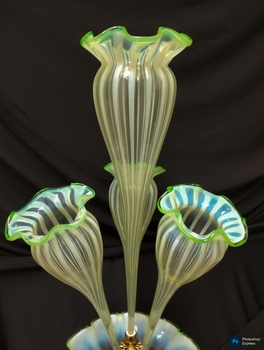Historical information
This glass epergne was first owned by John Sanderson's grandmother, who lived in Wandin (Clegg Road) until the 1940s. She first purchased it in 1920 and used it as a vase before passing it on to her daughter Norma Spicer.
Epergne's were first created during the early 18th century France as a table centrepiece to display 'exotic' fruits and cakes from France's colonies. They were originally made of silver, however, the late 18th century saw a rise in epergnes made of porcelain due to the growing status of the European porcelain industry. The late 19th century saw another shift as Victorian and Art glass became the name of the day, and most epergne's became increasingly more complex glass works, no longer used for holding food.
This epergne is the product of these later glasswork vases, reflecting 1920s interest in uranium glass and clouded geometric patterns. Epergnes like this filtered out of popularity after World War II as large dining sets and table centrepieces became less important to every day life. Those that remained transferred to more useful roles within the household: this one being used as a vase for most of its life.
Physical description
Green tinted glass epergne with white clouded vertical stripes. Glass thick and slightly opaque, possibly uranium glass. Base is a fruit bowl with scalloped/ruffle edges and middle coming up into a triangle. The very edges of the fruit bowl and clouded with white and blue.
A golden metal notion attaches to the middle of the fruit bowl with a globe shaped connector. Notion looks like a flat gold flower with six petals and three small leaves, with middle of the flower having a screw on which to screw the largest flute. The flower has three small bucket-shaped containers attached to it in which the smaller flutes are placed.
Four flutes attach from the very middle, all bell shaped with very ends flaring out into a scalloped/ruffle edge. One large flute is screwed into the middle of the fruit bowl and stands straight up. Three smaller flutes are placed in around the larger one leaning slightly away from the centre.






